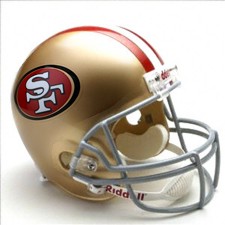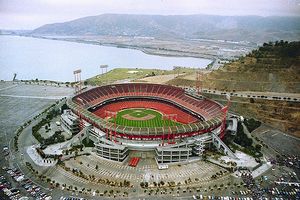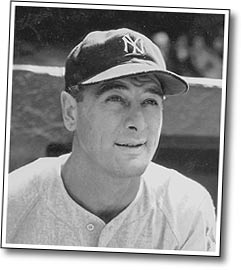 Bobby Waters, young quarterback in the NFL, held high hopes entering training camp for the San Francisco 49ers in 1962. The 24-year-old was vying to start in coach Red Hickey’s “shotgun” formation, banking on his athleticism in the run-and-gun offense to win the job. John Brodie and Billy Kilmer also contended at quarterback, but both lacked Waters’ ability to run with the football.
Bobby Waters, young quarterback in the NFL, held high hopes entering training camp for the San Francisco 49ers in 1962. The 24-year-old was vying to start in coach Red Hickey’s “shotgun” formation, banking on his athleticism in the run-and-gun offense to win the job. John Brodie and Billy Kilmer also contended at quarterback, but both lacked Waters’ ability to run with the football.
In a vicious flip side, however, the lanky Waters worried for his safety, as did any guy behind the center in pro football. Big, fast man-bulls chased down quarterbacks and pounded them, and while Waters’ talent for running the ball served his aspirations, it increased his vulnerability to brutal hits. Taking off up field in the NFL, Waters met waves of huge tacklers, seemingly multiplying around the league. A tough, native Georgian, Waters was a lithe figure with speed, but he was too skinny, down toward 180 pounds this season on his 6-foot-2 frame. He had endured broken bones since boyhood, among other injuries playing quarterback, but he was getting blasted by the athletic maniacs of pro football, flying at him from every direction, every play. Then the team doctor told Waters about pills that could “help you gain weight.” Dr. Lloyd Millburn, 49ers physician and surgeon, offered a sample pack of Dianabol, the anabolic steroid, in low-milligram tablets.
Pills for withstanding the NFL gauntlet? Anabolic steroids were completely new for Waters and athletes in general. “No one had heard of them really,” he later recounted, “or knew what they’d do.” Waters accepted the Dianabol, consumed it, and experienced the physical gains. For the next two years, until 1964, Waters obtained steroid pills from Dr. Millburn, intermittently and mostly in sample packs, to maintain his bodyweight at 200 to 210. He knew of more steroid users on the 49ers, and practically all players received prescription medication from staff, including amphetamines, painkillers, and cortisone injections.
“You have to view this within the context of the time,” doping historian Dr. Charles E. Yesalis said in 2008, discussing Waters and other early steroid users of football in contrast to modern athletes labeled cheaters by popular press and opinion. “[Steroids] were considered not-at-all controversial drugs in the ’60s. They were viewed more as super vitamins. It was an era when we were naive, or overly optimistic, about drugs as safe. … Viewed in context, anabolic steroids were very benign. It wasn’t controversial, it wasn’t considered illegal. … That was the start of this significant trend in our being a drug-taking society for legitimate purposes, for human capacities: to help you concentrate, to help you sleep, or help you get awake, or make you look better. Again, to not view performance-enhancing drug use by athletes within that greater context is a grave mistake, because as a society we use and have accepted a lot of things.”
Doctors brought anabolic steroids into football at every level, supplying players in high school as well as the pros. Dianabol reportedly hit prep football in 1959, soon after the drug’s release by Ciba Pharmaceuticals, according to a Texas physician who told Yesalis he provided the pills for a school team. Bil Gilbert of Sports Illustrated reported a “clandestine” experiment of Dianabol’s administering to prep players in the early 1960s, overseen by the team doctor in tandem with a pharmaceutical company; the program was shut down based on complaints to a state interscholastic commission. At Bloomington, California, in 1965, Dr. H. Kay Dooley organized a study involving three commercial brands of anabolic steroids for prep football players. “Dooley believes the drugs did increase muscle size and improve performance,” Gilbert wrote, “and he says there were no undesirable side effects.”
Dooley, who advised amateur and pro athletes, was a leading advocate of pharmaceuticals for performance in sport. “I don’t pretend to be a researcher or a scientist,” Dooley said in 1969. “I’m a practicing physician who is interested in athletes. A lot of physicians are stuffed shirts when it comes to sports. Athletes do want to perform better, that is what it is all about. If I know of something which may improve performance, a training or rehabilitation technique, a drug that is legal and which I don’t believe involves any serious health risk, I see no reason not to make it available to an athlete.”

Users of anabolic steroids in football often defied stereotypes, from the very beginning. Skill players, ball-carriers, for example, were prominent among earliest-known cases, including star running backs Joe Don Looney and Lance Rentzel of the Oklahoma Sooners. They were preceded by a skill-player in professional football, the 49ers’ Bobby Waters, who accepted Dianabol from a team physician in 1962 to gain bulk for withstanding the relentless tacklers of the NFL.
Waters hardly fit the image of a football juicer, particularly in the perception of future generations. No lineman or linebacker, Waters played quarterback, the game’s dignified position of higher intellect. He was no psycho behemoth but a slender, nice guy, a Southern gentleman who respectfully met a young woman’s parents over dinner in Lafayette, California, before taking her out on a date–and then marrying Sheri Gidley. Waters fashioned no grand scheme about anabolic steroids, no plans for super feats on the field and a rich payoff. Instead, Bobby Waters represented the common man’s quarterback, a hard worker from small-town Georgia by way of Presbyterian College in South Carolina, trying to carve out his niche in pro football. And steroid use did not guarantee longevity for Waters, not in the NFL, where he lasted five injury-marred seasons, mostly as a substitute. His pro career ended with a shattered right arm in 1964, requiring surgical insertion of a metal plate and screw. He gave up playing and entered college coaching.
Eventually, in an act rare for football, Waters publicly discussed his steroid use, while stricken by the fatal illness amyotrophic lateral sclerosis,  or “Lou Gehrig’s disease.” In the 1980s Waters became part of an extraordinary ALS cluster, three victims from one football team of the past, the 1964 San Francisco 49ers. After Waters watched two former 49ers mates succumb to ALS, Matt Hazeltine and Gary Lewis, he waged war on the dreaded disease.
or “Lou Gehrig’s disease.” In the 1980s Waters became part of an extraordinary ALS cluster, three victims from one football team of the past, the 1964 San Francisco 49ers. After Waters watched two former 49ers mates succumb to ALS, Matt Hazeltine and Gary Lewis, he waged war on the dreaded disease.
Waters strove foremost to raise awareness of ALS, a creeping paralysis that cut off motor function incrementally, by muscle groups, as the brain remained fully cognizant. But he also chased a cure for saving himself, a virtual impossible dream. “The only other choice I have is to lie down and wait for death, and I’m not ready for that,” Waters told People magazine in 1987. “My goal is to get well.” The former quarterback, tough as an Appalachian pine knot, continued working as the head football coach at Western Carolina University. The school’s most successful football coach in history, Waters believed the job kept him alive.
Waters was diagnosed with ALS following three years of symptoms. He lost use of his arms as the disease advanced, taking him down slowly. By early 1987 he was still moving upright on sound legs, but his quest for information, to locate a common denominator among the ex-49ers with ALS, had taken the urgency of a man on short time. Hazeltine and Lewis were gone and media were listening to Waters, picking up this sensational story of 3 men once together on a football roster of 48, whose shared disease averaged 1 or 2 cases per 100,000 Americans.
No cause was known for ALS, but a popular theory focused on environmental exposure to toxins. During media interviews, Waters said possibilities for the 49ers cluster included a fertilizer on practice fields and toxic batches of dimethyl sulfoxide, DMSO, the topical ointment to numb pain. He also pointed to the team’s mass dispensing of pills and other treatment to players to players during the 1960s, including cortisone injections, painkillers, and anabolic steroids. Waters revealed his use of Dianabol to reporters such as Bill Brubaker, Washington Post, saying he knew more juicers on the 49ers but offering no names. “I doubt that Bob was the only player using anabolic steroids,” his widow, Sheri Waters, said later, “but I truly don’t know who else. There was some talk, but not much.”
In 1987 Bob Waters and the 49ers skirmished over team records, but an accord was reached and the parties worked together to raise ALS awareness as well as research funds. “He didn’t really feel like the 49ers had anything to do with his disease,” Sheri Waters recalled in 2008. “He wanted to have [experts] research the coincidence between him and two teammates. … The 49ers office originally sort of stonewalled Bob’s questions, because they thought he was trying to build a lawsuit. But I think once they realized that was not the case, they were pretty straightforward with it.
A research team examined the 49ers cluster, led by Dr. Stanley H. Appel, an ALS expert who treated Waters and chaired the neurology department at Baylor College of Medicine, Houston. “I was denied almost all medical records by the 49ers medical staff,” he later stated. “However, we could not attribute the ALS to any of the substances we did investigate such as DMSO and ‘Milorganite’ [fertilizer].” Appel confirmed Dianabol was dismissed as a possible agent, stating “no form of steroids, including anabolic steroids, has been documented to cause or to aggravate ALS.”
Sheri Waters volunteered alongside her husband for the drive against Lou Gehrig’s disease. “We were really working hard to find a needle in a haystack,” she said. “I think what we did accomplish was, we drew a lot of attention to that particular disease, and the Muscular Dystrophy Association started giving a larger percent of its money into [ALS] research. Research doctors started pooling the information for sharing advances..”
Confined to a wheelchair at the end, paralyzed and disfigured, Bob Waters continued appearances and interviews, generating publicity for the cause. He died in 1989, distinguished for his football career and courageous fight against ALS. “Bob really put himself out there and gave up his vanity to get people interested,” Sheri said admiringly. “I think he’ll always have the legend of that football coach, or player, who died of Lou Gehrig’s disease and did what he could to try to figure it out. So I’m very proud of that.”
To order Spiral of Denial, Matt Chaney’s definitive book on steroid use in Football, visit http://shop.4wallspublishing.com/
